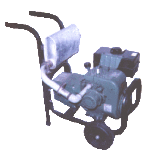The following article about storing fuel for your generator was submitted by Dave Hooper from Vancouver, BC Canada.
Tips on Fuel Storage
Gasoline does NOT store well. In fact, if you have ever made the mistake of putting your lawnmower away in the fall with gas in the tank and then trying to start it the following spring, you'll know what I mean. (And just how much did it cost to get it serviced? Do you know that the service mostly consisted of cleaning the stale gas, gum & varnish out of the carburetor, and putting fresh gas in?)
Is your generator going to start when you really need it?
 DO NOT store your generator with gas in the tank. (Even if it has a fuel shut off valve between the tank and the carb — I have never yet seen a shut-off valve that is 100% effective.)
DO NOT store your generator with gas in the tank. (Even if it has a fuel shut off valve between the tank and the carb — I have never yet seen a shut-off valve that is 100% effective.)
Paradoxically, do not allow it to sit for years without running it, either. So, once every 6 months or so, put a small amount of gas in it, start it, run it (preferably under load so we can exercise the entire unit!), and run it till it runs out of gas. (Don't fill the tank, or your test runs will last for hours!)
Since my machine gets the occasional workout powering a P.A. system at open air events, and has been known to power the pitching machine at a little league practice, this is not a major issue for me, but, it IS one more thing for your checklist.
So, we need a supply of gas that is NOT in the generator's tank. How much?
Well, if "survival unassisted for 72 hours" is to be the yardstick, how many hours out of that 72 will you be actually running the generator? Remember that the fridge will STAY cold if you can run it a few times a day for an hour or so each time, ditto the freezer, and the furnace fan won't have to be on all the time either. During daylight hours, you don't need lights, and you might want peace & quiet at night, so I suspect that a total of about 5 - 6 hours per day should do it, but let's assume (for this example) a total of 8 hours per day. What is the real (actual) fuel consumption of your generator, (gallons per hour) times 8 hours per day, times 3 days. A "2 gallons per hour" machine will need to have 2 x 8 x 3 = 48 gallons on hand!
(Now lets go back and see if we really need a generator THAT big!)
Maybe we can get by with one a bit smaller, using the bigger one only if needed. In other articles, the owner of TheEpicenter.com detailed his two machines: a teeny (500 watt) one for "continuous" run, and a 2250 watt beast to power a circular saw etc, for emergency repairs. The big guy needs a gallon an hour, so the webmaster would need to have at least 24 gallons in storage in the above example, while the little one may drink as little as 8 or 12 gallons in total. In the webmaster's case, I would suggest about 20 gallons as a bare minimum — enough to run the little one for a long time, with reserve fuel for the bigger one as required, or conversely, a reserve of fuel should a longer period of self-sufficiency be required.
So, now we can figure out HOW MUCH gas to keep on hand, how do we store it?
There are products out there called Sta-Bil. These are fuel stabilizers and are supposed to prevent gas from breaking down. USE IT!
Fuel stabilizers are available at many hardware, "big box" home supply stores, automotive stores and places where mowers and chainsaws are sold.
Note from TheEpicenter.com: Very good fuel treatment products are available. Please see our article about Fuel Degradation in Storage.)
But don't keep the gas around forever, either. Just as with everything else, rotate your stock.
I keep several 5 gallon gas cans full, and I also ensure that I do not keep any one of them more than 6 months. I simply rotate the stock, by putting the oldest gas into the car, and refilling the gas can at the service station, adding fuel stabilizer each time. If you only need to have 12 gallons on hand, get three 5 gallon cans (15 gallons total), and once a month put one into your car, and then refill it, putting it at the back of the row. Next month, put the next one in, etc. If you "rob" your supply to fill the lawn mower, that's fine, too, just make sure you keep minimums on hand.
DO NOT KEEP GAS IN THE HOUSE!
 Keep your stored fuel in the garden shed, the "pallet root cellar," or the garage (only if it is not attached to the house) or wherever else is fine. But NOT in the house! Gasoline is DANGEROUS!
Keep your stored fuel in the garden shed, the "pallet root cellar," or the garage (only if it is not attached to the house) or wherever else is fine. But NOT in the house! Gasoline is DANGEROUS!
In case of an earthquake or whatever, there is a risk of fire. Do you want to have 15 or 20 gallons of highly explosive, extremely flammable stuff in your house? What happens in case of a "normal" house fire? (They DO happen — no one is immune?)
So, figure out your needs, get the gas in convenient, easy to use sizes, use a fuel stabilizer, rotate the stock, and store it securely away from the house. Now your emergency, standby generator might actually do some good!
Forget the car gas tank as a source. This will prove to be the ONE TIME that the car is nearly empty, and besides, have you ever tried to siphon gas out of a modern car? With all those vapor traps, and emissions things, it will prove to be nearly impossible!)
On a final note, a small, 1 or 2 gallon gas can should be kept handy for filling the generator's tank. It is easier to manage than the 5 gallon size for filling the relatively small tank on the generator. At my house, my wife is physically not large enough to handle the 5 gallon size with any accuracy, but could use one of the big ones to fill the smaller can, and then gas up the generator with the little can, should anything happen while I am away. The little can won't go to waste--use it for your ongoing supply of lawnmower gas!
Oh, one more thing: Give the generator's engine the occasional oil change. Once a year should be fine unless you are using it a lot. Oil, like fuel, deteriorates over time (and use) as well as attracting contaminants, so pay attention to that detail too. After all, chances are good that your generator doesn't even take a full quart of oil! Again, minimal cost for peace of mind when you need it.
On a related topic, get another one-gallon can, and a bottle of 2-stroke mixer oil as well. Again, do not keep a can of mixed fuel around--it will deteriorate, but your chain saw (you DO have one, don't you?) will also need to be fed, and will be invaluable for getting those downed trees out of the way, off the house, away from your root cellar, etc. Mix the fuel only as required, so you will keep it fresh as well.
Remember, YOYO! (You're On Your Own)
-- Dave Hooper
About this article's submitter: David says: "I am a Canadian Civil Servant, with the Department of Indian Affairs and Northern Development, in the British Columbia Region. Part of my job responsibilities involve Emergency Preparedness for First Nations Communities."
Note from TheEpicenter.com: If you are looking for a great fuel treatment to store and stablize your fuel storage (or restore degraded fuels), we highly recommend the PRI-G (Gasoline) and PRI-D (Diesel/Kerosene) Fuel Treatments. Please visit our Fuel Treatments page @ TheEpicenter.com.



